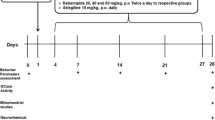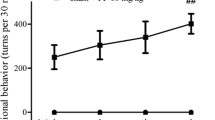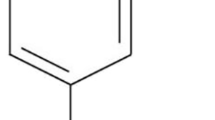Abstract
Rosmarinic acid (RA) is a naturally occurring polyphenolic compound. It has been reported that RA possessed antioxidant and anti-inflammatory properties. Our previous study showed that RA could protect MES23.5 dopaminergic cells against 6-hydroxydopamine (6-OHDA)-induced neurotoxicity in vitro. The purpose of this study was to explore the neuroreparative (neurorescue) effect of RA on 6-OHDA-lesioned rat model of Parkinson's disease (PD) in vivo. In this study, the rats were given RA orally after intrastriatal 6-OHDA lesion. Results showed that the dopamine content in the striatum decreased and the numbers of tyrosine hydroxylase-immunoreactive neurons reduced after 6-OHDA treatment. RA treatment after 6-OHDA administration could restore these changes. Further studies demonstrated that 6-OHDA treatment increased the iron-staining positive cells, which were markedly decreased by RA treatment. Moreover, RA suppressed the increased ratio of Bax/Bcl-2 at gene level induced by 6-OHDA. This indicates that the neurorescue effects of RA against 6-ODHA-induced degeneration of the nigrostriatal dopaminergic system were achieved by decreasing nigral iron levels and regulating the ratio of Bcl-2/Bax gene expression.





Similar content being viewed by others
References
Blum D, Torch S, Lambeng N, Nissou M, Benabid AL, Sadoul R, Verna JM (2001) Molecular pathways involved in the neurotoxicity of 6-OHDA, dopamine and MPTP: contribution to the apoptotic theory in Parkinson's disease. Prog Neurobiol 65:135–172
Du T, Li L, Song N, Xie J, Jiang H (2010a) Rosmarinic acid antagonized 1-methyl-4-phenylpyridinium (MPP+)-induced neurotoxicity in MES23.5 dopaminergic cells. Int J Toxicol 29:625–633
Du T, Song N, Xie J, Jiang H (2010b) Iron chelation of rosmarinic acid. Med J Qilu 25:399–401
Earl CD, Reum T, Xie JX, Sautter J, Kupsch A, Oertel WH, Morgenstern R (1996) Foetal nigral cell suspension grafts influence dopamine release in the non-grafted side in the 6-hydroxydopamine rat model of Parkinson's disease: in vivo voltammetric data. Exp Brain Res 109:179–184
Emdadul Haque M, Asanuma M, Higashi Y, Miyazaki I, Tanaka K, Ogawa N (2003) Apoptosis-inducing neurotoxicity of dopamine and its metabolites via reactive quinone generation in neuroblastoma cells. Biochim Biophys Acta 1619:39–52
Gal S, Zheng H, Fridkin M, Youdim MB (2010) Restoration of nigrostriatal dopamine neurons in post-MPTP treatment by the novel multifunctional brain-permeable iron chelator-monoamine oxidase inhibitor drug, M30. Neurotox Res 17:15–27
Gao LP, Wei HL, Zhao HS, Xiao SY, Zheng RL (2005) Antiapoptotic and antioxidant effects of rosmarinic acid in astrocytes. Pharmazie 60:62–65
Gao QG, Chen WF, Xie JX, Wong MS (2009) Ginsenoside Rg1 protects against 6-OHDA-induced neurotoxicity in neuroblastoma SK-N-SH cells via IGF-I receptor and estrogen receptor pathways. J Neurochem 109:1338–1347
Iuvone T, De Filippis D, Esposito G, D'Amico A, Izzo AA (2006) The spice sage and its active ingredient rosmarinic acid protect PC12 cells from amyloid-beta peptide-induced neurotoxicity. J Pharmacol Exp Ther 317:1143–1149
Jiang H, Luan Z, Wang J, Xie J (2006) Neuroprotective effects of iron chelator Desferal on dopaminergic neurons in the substantia nigra of rats with iron-overload. Neurochem Int 49:605–609
Jiang H, Song N, Wang J, Ren LY, Xie JX (2007) Peripheral iron dextran induced degeneration of dopaminergic neurons in rat substantia nigra. Neurochem Int 51:32–36
Jiang H, Song N, Xu H, Zhang S, Wang J, Xie J (2010) Up-regulation of divalent metal transporter 1 in 6-hydroxydopamine intoxication is IRE/IRP dependent. Cell Res 20:345–356
Kane DJ, Sarafian TA, Anton R, Hahn H, Gralla EB, Valentine JS, Ord T, Bredesen DE (1993) Bcl-2 inhibition of neural death: decreased generation of reactive oxygen species. Science 262:1274–1277
Ke Y, Qian ZM (2003) Iron misregulation in the brain: a primary cause of neurodegenerative disorders. Lancet Neurol 2:246–253
Korsmeyer SJ (1995) Regulators of cell death. Trends Genet 11:101–105
Lee HJ, Cho HS, Park E, Kim S, Lee SY, Kim CS, Kim do K, Kim SJ, Chun HS (2008) Rosmarinic acid protects human dopaminergic neuronal cells against hydrogen peroxide-induced apoptosis. Toxicology 250:109–115
Ma ZG, Wang J, Jiang H, Liu TW, Xie JX (2007) Myricetin reduces 6-hydroxydopamine-induced dopamine neuron degeneration in rats. Neuroreport 18:1181–1185
Mandel S, Grunblatt E, Riederer P, Gerlach M, Levites Y, Youdim MB (2003) Neuroprotective strategies in Parkinson's disease: an update on progress. CNS Drugs 17:729–762
Offen D, Beart PM, Cheung NS, Pascoe CJ, Hochman A, Gorodin S, Melamed E, Bernard R, Bernard O (1998) Transgenic mice expressing human Bcl-2 in their neurons are resistant to 6-hydroxydopamine and 1-methyl-4-phenyl-1,2,3,6- tetrahydropyridine neurotoxicity. Proc Natl Acad Sci U S A 95:5789–5794
Oltvai ZN, Milliman CL, Korsmeyer SJ (1993) Bcl-2 heterodimerizes in vivo with a conserved homolog, Bax, that accelerates programmed cell death. Cell 74:609–619
Onyango IG (2008) Mitochondrial dysfunction and oxidative stress in Parkinson's disease. Neurochem Res 33:589–597
Petersen M, Simmonds MS (2003) Rosmarinic acid. Phytochemistry 62:121–125
Ren P, Jiang H, Li R, Wang J, Song N, Xu HM, Xie JX (2009) Rosmarinic acid inhibits 6-OHDA-induced neurotoxicity by anti-oxidation in MES23.5 cells. J Mol Neurosci 39:220–225
Rouault TA (2001) Iron on the brain. Nat Genet 28:299–300
Sayre LM, Perry G, Smith MA (2008) Oxidative stress and neurotoxicity. Chem Res Toxicol 21:172–188
Swarup V, Ghosh J, Ghosh S, Saxena A, Basu A (2007) Antiviral and anti-inflammatory effects of rosmarinic acid in an experimental murine model of Japanese encephalitis. Antimicrob Agents Chemother 51:3367–3370
Vila M, Jackson-Lewis V, Vukosavic S, Djaldetti R, Liberatore G, Offen D, Korsmeyer SJ, Przedborski S (2001) Bax ablation prevents dopaminergic neurodegeneration in the 1-methyl- 4-phenyl-1,2,3,6-tetrahydropyridine mouse model of Parkinson's disease. Proc Natl Acad Sci U S A 98:2837–2842
Wang J, Jiang H, Xie JX (2004) Time dependent effects of 6-OHDA lesions on iron level and neuronal loss in rat nigrostriatal system. Neurochem Res 29:2239–2243
Wang J, Xu HM, Yang HD, Du XX, Jiang H, Xie JX (2009) Rg1 reduces nigral iron levels of MPTP-treated C57BL6 mice by regulating certain iron transport proteins. Neurochem Int 54:43–48
Youdim MB, Stephenson G, Ben Shachar D (2004) Ironing iron out in Parkinson's disease and other neurodegenerative diseases with iron chelators: a lesson from 6-hydroxydopamine and iron chelators, desferal and VK-28. Ann N Y Acad Sci 1012:306–325
Zecca L, Youdim MB, Riederer P, Connor JR, Crichton RR (2004) Iron, brain ageing and neurodegenerative disorders. Nat Rev Neurosci 5:863–873
Zhao J, Huang X, Tang W, Ren P, Xing Z, Tian X, Zhu Z, Wang Y (2007) Effect of oriental herbal prescription Guan-Xin-Er-Hao on coronary flow in healthy volunteers and antiapoptosis on myocardial ischemia-reperfusion in rat models. Phytother Res 21:926–931
Acknowledgments
This work was supported by grants from the National Program of Basic Research sponsored by the Ministry of Science and Technology of China (2011CB504102), the National Foundation of Natural Science of China (30930036), and the Natural Science Foundation of Shandong Province (Z2008C01, Z2008C06).
Author information
Authors and Affiliations
Corresponding authors
Additional information
Jieyu Wang and Huamin Xu are the co-first authors.
Rights and permissions
About this article
Cite this article
Wang, J., Xu, H., Jiang, H. et al. Neurorescue Effect of Rosmarinic Acid on 6-Hydroxydopamine-Lesioned Nigral Dopamine Neurons in Rat Model of Parkinson's Disease. J Mol Neurosci 47, 113–119 (2012). https://doi.org/10.1007/s12031-011-9693-1
Received:
Accepted:
Published:
Issue Date:
DOI: https://doi.org/10.1007/s12031-011-9693-1




